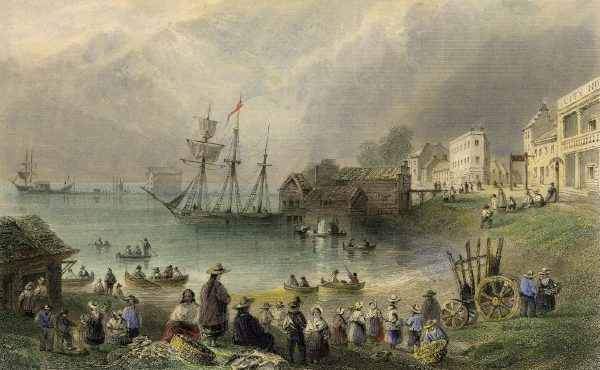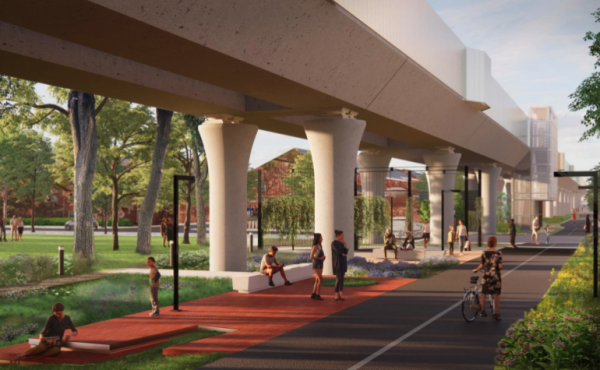
As I’ve noted in passing in some previous posts, the City of Toronto is currently developing a “Walking Strategy” to guide Toronto towards becoming a more walkable city.
The city is currently in its public consultation phase, and is looking for input from the citizens. It has held three public consultations, which were well-attended, but there are many other walkers out there who it has not yet heard from.
City staff have put together a discussion document, “Steps Towards a Walkable City,” which lays out the city’s current walking-related policies and some possible future actions. Staff are looking for feedback about what citizens feel are priorities, and ideas that might be added to the strategy.
I encourage everyone to read the document and send their feedback to the city.
– Download “Steps Towards a Walkable City” (PDF)
– See notes from consultations so far and other related documents
Send your feedback to: pedplan@toronto.ca
Notes from public consultation, Nov. 8, 2007
To give an idea of possible feedback, I made a couple of notes from the Nov. 8 public consultation meeting of ideas expressed by people in my breakout group that I found really interesting.
In response to the “coordinated street furniture program” that the city has adopted, several people noted (as I did in a post when the program was being discussed) that there’s a danger that homogenization will create a boring walking environment. One person expressed the need for variety by calling for an “uncoordinated” street furniture program — I thought this was a nice way to put it.
Another person noted the need to look for where people already want to walk, and put paths there — for example, where footpaths have been worn in, or fences have been cut. Too often these kinds of grassroots paths are treated as problems rather than opportunities to make walking easier.
There were lots of other great ideas, but I hope many of our readers will provide their own to the city.
Advance Pedestrian Signals
The city recently approved the concept of introducing advance pedestrian signals in some Toronto intersections. They allow pedestrians to get out into the crossing and establish their presence before cars start turning left, and so are useful for making pedestrian crossings safer at busy one-way streets and T-intersections (they are more widely useful in Quebec where right turns aren’t allowed on a red).
The city has, in fact, been running a pilot project at the intersection of University and Adelaide — check it out if you are in the area and watch to see how the “walking man” comes on a few seconds before the traffic light turns from red to green when crossing University eastwards.
Photo by plastictaxi.



14 comments
You know, I’m constantly bugged about how people’s work perspective determines how they solve a problem….if you are a traffic engineer you tweak the lights at intersections, if you work for the ttc you worry about offload times and train routing.
Meanwhile in the real world the actual user “experience” is ignored.
Here’s an example – the city does not clean the University Ave. middle island sidewalks of snow. If you are one of a zillion office workers crossing at Dundas and University you hit a big patch of unshovelled snow in the middle of your attempt to cross University. (until it melts 4 days later) But hey the lights have been tweaked. I ache for a ground level cross-departmental manager who can “read” the experience of users and marshall the necessary efforts from different but unconnected branches of government.
While I’m on a mini-rant here – the other experience that I’m stunned about is that transit authorities miss a stunning 50% of the user experience. The transit experience is defined by “waiting for transit” and “using transit”. Other than selling eyeballs for tv screens during wait time and publishing ineffective “a streetcar every 8 min” transit stop signs the user 50% wait time experience is totally ignored.
Meanwhile in Vancouver – bus stops display, via scrolling lcd info panels the accurate arrival time of surface vehicles. Want to duck into a shop to buy a coffee…you’ve got 12 min before the bus arrives. In Toronto – no idea.
So hey planners of all stripes – get out of your offices, talk to actual users and experience what they experience first hand.
A manager of the user experience of the city is a brilliant idea.
—
Re: University Boulevard sidewalk. It’s my understanding that (and I maybe be screwing this up a bit) it was a provincial responsibility. This goes back to the days of Metro, where University was a “Metro Road” but the province, for some strange reason, controlled the centre. The controversial “Gumby Goes to Heaven” airman’s memorial at Dundas was installed without the city/metro’s knowledge, sort of overnight (a gift from Hal Jackman I think).
I cannot remember if I heard this conjecturally or in something like Fulford’s Accident City book. So consider it rumour and innuendo for now.
It’s a great initiative, but I’m not sure it will bring the results…
In fairness the TTC is working toward implementing a bus arrival info system similar to that found in Vancouver.
As far as traffic signals, there is a lot the city could do to improve conditions for pedestrians. -Traffic signals should always include a pedestrian phase by default.- Replace those flashing-yellow crosswalks with full-fledged traffic signals. Too many drivers ignore the crosswalks and it’s dangerous.- At intersections that have a pedestrian button, the waiting time between pressing the button and getting the signal is WAY too long and needs to be dramatically reduced. It should be no more than 30 seconds IMO.Another thing that would help pedestrians is adding surface transit to shopping streets that don’t have it, Yonge and Bloor streets being prime examples. When you’re tired, or it’s cold, and you want to go a kilometre or so, a bus would really help. This would especially benefit the elderly.
“At intersections that have a pedestrian button, the waiting time between pressing the button and getting the signal is WAY too long and needs to be dramatically reduced. It should be no more than 30 seconds IMO.”
It’d be nice if pedestrians could control intersections but that opens them up to a lot of abuse. I think a 30 second delay would be a really bad idea.
Another advantage to bus arrival time displays: if I know I have a few minutes then I’ll walk over to the next stop (I hate standing around waiting). There’s also the “walk home or wait for the bus” gamble from the subway station. If I choose to walk, inevitably the bus passes by when I’m still within one block of the station. If I wait, the expected bus never shows up. I suppose it would be too much to ask for my transfer to be valid anywhere along the bus route… then I could walk halfway home and hop on the bus for the rest of the way.
I should probably just take up yoga and spend my wait time in contemplative meditation.
The pedestrian “network” that exists in Hong Kong is interesting. Instead of having cross walks across (some) wide/busy streets, they use pedestrian only bridges. They aren’t as steep as the few we have in Toronto and are therefor more friendly to a wide variety of pedestrians. This avoids creating more traffic/pollution from cars and pedestrians having to wait.
Toronto is great at holding conferences and creating strategies but I’m too skeptical to think any real action is going to come of this.
Dabusan > the “cross-departmental manager” is one of the things the city is working on, although I’m not sure it will take care of this particular problem.
Charles > some of the flashing-yellow crosswalks have indeed been converted to full traffic lights this year. The others are being improved.
The fact that people waiting for the TTC are pedestrians and need to be considered (by both the TTC and the city) is a really good point.
I hope everyone who has made a suggestion has sent it in to the city at the address I provided!
i live in montreal, in the plateau. I find that the bike lanes employed here are great additions to the street because they add another curbed buffer zone from street traffic.
Also, the TREES! we have such lovely huge silver maples that line the street! toronto has their toothpick-sized, malnourished, underprepped, norwegian maples that die so quickly and never reach maturity. Any à ˆworld-classà ˆ city (as toronto claims to be) – paris, tel aviv, marseilles, etc. has massive healthy, respected trees on the street. What better street furnishing is thereà ‰
One suggestion I would like to make (and have made), is to examine, and try to eliminate, all traffic light controlled intersections where pedestrians cannot cross at all four corners. Examples I know of are Front / University and Bay / Lakeshore but I am sure there are many others. I admit that SOMETIMES it may be too dangerous to allow pedestrians to cross at all corners but I do suggest that all such crossing be critically examined.
Ploughing the sidewalks properly — i.e. picking the snow up and taking it away, as in Montreal, rather than piling it by the curb — would help a lot. The sidewalks on post-ROW St. Clair are plenty narrow already.
Davenport and Spadina is another one of those intersections where pedestrians can only cross on one side…in this case, making it MORE difficult for cars to turn left onto Davenport, especially during rush hour. I’ve never understood that one.
Speaking of plowing the sidewalks, and using Vancouver as a model, why don’t we see more awnings protecting the sidewalks in this city?
Awnings protect pedestrians from the rain, snow and ice. In Vancouver, you can walk down Robson street on a rainy day and stay almost completely dry (which to me is very pedestrian friendly). It seems to be very rare for new buildings in Toronto to have similar awnings. Is this because we tax them? (see https://spacing.ca/toronto//?p=1435).
With regards to snow on sidewalks, I think the regulations are negatively enforced, and therefore don’t orient neighbourhoods around a common goal. The current law indicates that a home owner/dweller is responsible for shovelling the snow on the sidewalk in front of their house within 12 hours of a major snowfall, or else they will be fined. In residential hoods, those who tend to walk tend to shovel their walks sooner than later, while those who tend to drive tend to leave them, sometimes to the point of turning into immovable ice patches.
What if the enforcement was incentive based? Something like, you will receive some kind of recognition or even a small tax-rebate if you shovel the sidewalk on your neighbours property, especially if they’re on vacation, or otherwise unable to take on the physical task.
Toronto really needs to improve the walkability of the University of Toronto campus, which has too many cars running through it. St. George and Harbord streets have a fair amount of traffic, and Queen’s Park has extremely heavy traffic despite the presence of a subway line directly beneath it. Crossing Queen’s Park to get from one side of campus to the other is quite a challenge, especially since there are few pedestrian crossings and those that exist are dangerous. Queen’s Park should be narrowed and have more signalized pedestrian crossings, and St. George and Harbord should have more traffic calming (or perhaps they should even be pedestrianized).